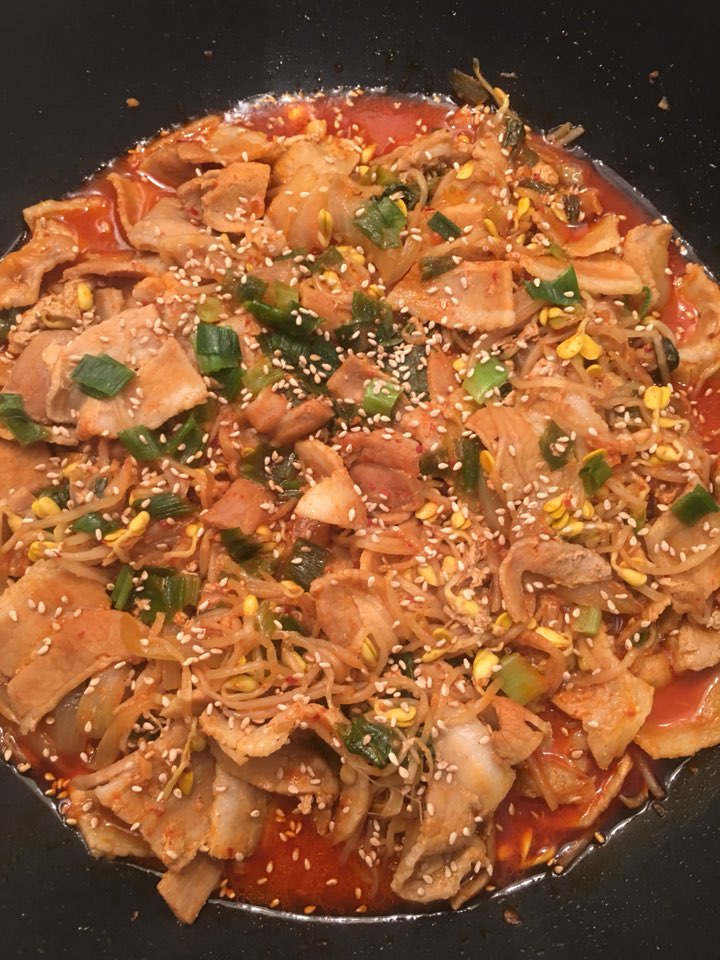How to Make Korean Soybean Sprout Bulgogi Posted by Flying Oyster on Oct 9, 2019 in Uncategorized
One day, I told my friend how much I miss Korean 집밥 (jib-bob: homemade food). She said that she often soothes her stomach with 콩불 (kong-bool: a Korean dish. It is short for 콩나물 불고기: kong-nah-mul -bul-go-gi: soybean sprout Bulgogi). She couldn’t stop talking about how satisfying this dish can be whenever she craves Korean food in 타지 (tah-gee: foreign country). To be honest, when she first mentioned 콩불, I didn’t even know such a dish existed. I initially thought she meant she had 불고기 (Bulgogi: a Korean dish which is soy sauce marinade meat dish) with 콩나물 (kong-nah-mul: soy bean sprout) 반찬 (bahn-chan: side dish). Apparently, my knowledge of Korean cuisine is outdated. 콩불 has been a popular menu item in Korea for more than a couple years.
Bulgogi is a well-known Korean dish, even in America. It is still loved by so many people, but I guess Koreans started enjoying 불고기 in a different way these days. A new version of 불고기, 콩불 can satisfy your 미각 (mee-gak: palate, taste buds).
콩나물 불고기 is spicy, but still sweet and salty. The secret of this dish is coming from 콩나물, which is basically served as a broth to accompany the dish. 콩나물 ooze out its juice as they are cooked, then the juice is beautifully mixed with a spicy sauce to cook the meat. I believe that whoever invented this dish really understood the joys of Korean food. I must share this recipe because it makes me 군침 돌다 (goon-chim-dol-dah: it is mouth-watering).
예상 조리 시간 (yea-sang-jo-ree-si-gahn: estimated cooking time) : 15 minutes
재료 (jae-ryo: ingredients)
- 콩나물 (kong-nah-mul: soybean sprouts) *숙주나물 (sook-joo-nah-mul: mung bean sprouts) is different from 콩나물. You need 콩나물 for this recipe.
- 대패삼겹살 (dae-pae-sam-gyup-sal: thinly sliced pork belly)
- 야채 (yae-chae: vegetable)
- A half of 양파 (yang-pa: onion),
- 10 to 15 pcs of 깻잎 (ggat-it: sesame leaves),
- 1 stalk of 대파 (dae- pah: spring onion),
- 1-2 of 느타리 버섯 (nue-tah-ree-buh-sut: oyster mushrooms),
- 2 청양고추 (cheong-yang-goh-choo: cheongyang chili, you could substitute jalapeños)
4. 양념장 (yang-nyum-jang: sauce for marinade)
- 간장 (gahn-jang: soy sauce) 3 tbsp,
- 고추장 (goh-choo-jang: red pepper paste) 3 tbsp,
- 고추가루 (goh-choo-gah-roo: red pepper powder) 3 tbsp,
- 설탕 (seol-tang: sugar) 2 tbsp,
- 다진 마늘 (dah-jin-mah-nul: minced garlic) 2 tbsp,
- 맛술 (math-sul: cooking wine) 3 tbsp,
- 참기름 (cham-gee-ruem: seasame oil) 1tsp *It is optional.
- Prep vegetables: wash all vegetables and drain 콩나물. Cut up 대파 and 청양고추 diagonally. Slice 양파, 깻잎, 버섯 thinly. You are going to use 깻잎 for cooking and garnish. If you like 깻잎, save some fresh 깻잎 for your garnish.
- Make the spicy sauce using 양념장 ingredients above.
- Place 콩나물 on the bottom of a wok. Add the vegetables on the second layer, on top of 콩나물 then place your meat on top of everything. This is an important step because 콩나물 on the bottom and the vegetables on the second layer will create broth for your meat. You don’t add water for this recipe.
- Add one tablespoon of spicy sauce. Cook them on 중불 (joong-bul: medium heat).
- Once you see the broth from vegetables is boiling, add 1-2 more tablespoons of the sauce depending on your preference. Stir ingredients well.
- Cook another 3-5 minutes until meat is completely cooked.
- Put fresh 깻잎 on top of your dish as a garnish, if you like 깻잎.
- Enjoy!

Build vocabulary, practice pronunciation, and more with Transparent Language Online. Available anytime, anywhere, on any device.





